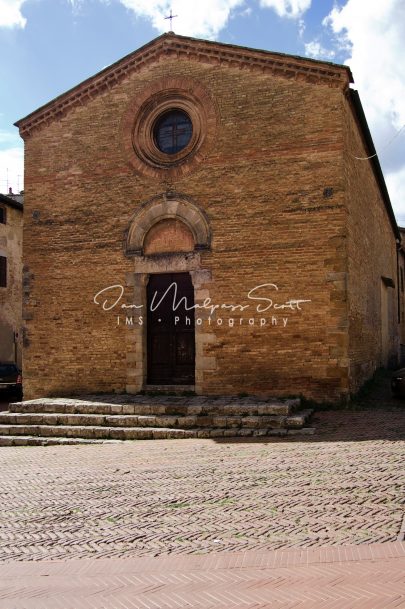![]()
The church of San Pietro in Forliano is located in San Gimignano, in the province of Siena, Diocese of Volterra
The first testimony that certifies the existence of this church dates back to 28 December 1262 when a certain Noccio, Guiciardo, left 10 sous to the ecclesiastical in his will. s. Petri de Forliano. Subsequently the church was no longer mentioned neither among the churches confirmed at the proposal of San Gimignano in 1182 by Pope Lucius III and in 1254 by Pope Innocent IV, nor in the lists of tithes drawn up between the end of the 13th and the beginning of the 14th century. Probably for an unspecified period the church was deconsecrated given that in 1318 it appears that Biondo Guareducci of Pisa, a wool merchant in Siena, used it as his warehouse. It appears cited again, as eccl. Blessed Petri de S.Geminiano on 20 September 1328 when the chapter of the collegiate church elected priest Cione di Chele as its rector.
In the mid-14th century the economic situation of the church was good and it could count on decent income which allowed its rectors to decorate the interior with frescoes by artists such as Memmo di Filippuccio and Giovanni d’Asciano. The problem of the church was its extreme proximity to the convent of Sant’Agostino, which took away faithful from it and which took away the usefulness of its function as a parish church; in fact, on the occasion of the pastoral visit of 24 January 1441, the church was already united with the parish church of Céllole for an unspecified time. In 1556 it became a possession of the monks of the Badia a Cerreto who, however, kept it closed to worship and in 1565 handed it over to the convent of the Angels. Their government lasted very little given that already in 1576 it was once again united with the parish church of Cèllole and looked after by the canons of the collegiate church.
In 1595 it was erected again as a parish and although it was located in the territory of the new diocese of Colle Val d’Elsa, it was left and still constitutes a sort of enclave of the diocese of Volterra.
In 1918 its frescoes were consolidated and restored and the façade was restored to its original style, with work considered truly exemplary for the time.
The church consists of a simple rectangular room covered with a roof.
External
The facade has a gabled layout with an oculus superimposed on the portal, according to a classic scheme from the early 13th century. The portal has an arch made of limestone ashlars, slightly extradosed with a wraparound ring in Pisan style and with the architrave of brackets carved with human heads; the lunette is infilled using bricks arranged in a fishbone pattern with a system also used in the parish church of Casole. The eye is the result of restoration and to do this the fragments saved from destruction following the insertion, in its place, of a large rectangular window were used.
Externally it shows quite clearly two distinct construction phases in the medieval era; on the bare northern side there is a clear stitching of the brick masonry: on the right is the oldest part and on the left the most recent. The southern side corresponds to the ancient facade where a portal opened, the lunette and the jambs are the result of a reconstruction, with an extradosed arch in Pisan style and a ring composed of terracotta sculpted with cords and dentils. In the part above there are three double-lancet single-lancet windows with an archivolt with zig-zag decoration, these single-lancet windows are symmetrical with respect to the portal. On the left of the portal there is a single-lancet window of smaller dimensions than those above, which presents elements dating back to the end of the 12th century.
The church has a bell tower resulting from subsequent restorations.
Internal
The interior, with a single hall, preserves interesting frescoes from the first half of the fourteenth century. Memmo di Filippuccio created the Annunciation, the Madonna enthroned between two saints and the Adoration of the Magi. The fresco with the unusual iconography, with the Madonna walking holding Jesus’ hand, between Saint Paul and Saint John the Baptist, is historically attributed to Giovanni d’Asciano, although recent studies have cast doubt on the existence of this artist, identifying the author with a painter from the Memmi workshop, perhaps Federico.


